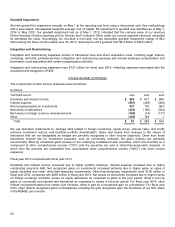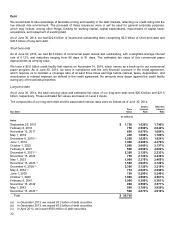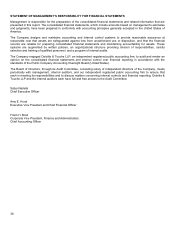Microsoft 2014 Annual Report Download - page 37
Download and view the complete annual report
Please find page 37 of the 2014 Microsoft annual report below. You can navigate through the pages in the report by either clicking on the pages listed below, or by using the keyword search tool below to find specific information within the annual report.36
Judgment is also required to assess whether future releases of certain software represent new products or upgrades and
enhancements to existing products. Certain volume licensing arrangements include a perpetual license for current
products combined with rights to receive unspecified future versions of software products (“Software Assurance”) and are
accounted for as subscriptions, with billings recorded as unearned revenue and recognized as revenue ratably over the
coverage period.
Software updates are evaluated on a case-by-case basis to determine whether they meet the definition of an upgrade,
which may require revenue to be deferred and recognized when the upgrade is delivered. If it is determined that implied
post-contract customer support (“PCS”) is being provided, revenue from the arrangement is deferred and recognized over
the implied PCS term. If updates are determined to not meet the definition of an upgrade, revenue is generally recognized
as products are shipped or made available.
Microsoft enters into arrangements that can include various combinations of software, services, and hardware. Where
elements are delivered over different periods of time, and when allowed under U.S. GAAP, revenue is allocated to the
respective elements based on their relative selling prices at the inception of the arrangement, and revenue is recognized
as each element is delivered. We use a hierarchy to determine the fair value to be used for allocating revenue to
elements: (i) vendor-specific objective evidence of fair value (“VSOE”), (ii) third-party evidence, and (iii) best estimate of
selling price (“ESP”). For software elements, we follow the industry specific software guidance which only allows for the
use of VSOE in establishing fair value. Generally, VSOE is the price charged when the deliverable is sold separately or
the price established by management for a product that is not yet sold if it is probable that the price will not change before
introduction into the marketplace. ESPs are established as best estimates of what the selling prices would be if the
deliverables were sold regularly on a stand-alone basis. Our process for determining ESPs requires judgment and
considers multiple factors that may vary over time depending upon the unique facts and circumstances related to each
deliverable.
Windows 7 revenue was subject to deferral as a result of the Windows Upgrade Offer, which started June 2, 2012. The
offer provided significantly discounted rights to purchase Windows 8 Pro to qualifying end-users that purchased Windows
7 PCs during the eligibility period. Microsoft was responsible for delivering Windows 8 Pro to the end customer.
Accordingly, revenue related to the allocated discount for undelivered Windows 8 was deferred until it was delivered or the
redemption period expired.
Impairment of Investment Securities
We review investments quarterly for indicators of other-than-temporary impairment. This determination requires significant
judgment. In making this judgment, we employ a systematic methodology quarterly that considers available quantitative
and qualitative evidence in evaluating potential impairment of our investments. If the cost of an investment exceeds its fair
value, we evaluate, among other factors, general market conditions, credit quality of debt instrument issuers, the duration
and extent to which the fair value is less than cost, and for equity securities, our intent and ability to hold, or plans to sell,
the investment. For fixed-income securities, we also evaluate whether we have plans to sell the security or it is more likely
than not that we will be required to sell the security before recovery. We also consider specific adverse conditions related
to the financial health of and business outlook for the investee, including industry and sector performance, changes in
technology, and operational and financing cash flow factors. Once a decline in fair value is determined to be other-than-
temporary, an impairment charge is recorded to other income (expense) and a new cost basis in the investment is
established. If market, industry, and/or investee conditions deteriorate, we may incur future impairments.
Goodwill
We allocate goodwill to reporting units based on the reporting unit expected to benefit from the business combination. We
evaluate our reporting units on an annual basis and, if necessary, reassign goodwill using a relative fair value allocation
approach. Goodwill is tested for impairment at the reporting unit level (operating segment or one level below an operating
segment) on an annual basis (May 1 for us) and between annual tests if an event occurs or circumstances change that
would more likely than not reduce the fair value of a reporting unit below its carrying value. These events or
circumstances could include a significant change in the business climate, legal factors, operating performance indicators,
competition, or sale or disposition of a significant portion of a reporting unit.
























